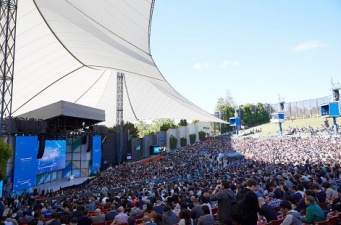Alex Handy takes a look back at Google’s I/O developer event to see how it’s changed over the years.
Google I/O finally got its swing back this year. After the move south to the Shoreline Amphitheater, the conference was a bit of a new idea last year, despite its illustrious history. While the conference had previously taken place in downtown San Francisco’s Moscone Center, the new venue makes it an altogether different experience, especially now that Google has settled in.
The new venue is directly next to Google’s campus, giving visitors better access to all those intelligent folks inside the company. This has been, traditionally, one of the main draws of the conference: the ability to speak to the important stakeholders in major Google projects. And while things are still much busier and more populous than in years past, it’s good to see that Google still offers office hours to visitors.
A Big Stack Of Information
Google I/O has morphed a bit over the years. This event was originally created as a way for Google to interact with its ecosystem of developers, then took a sideways turn into the realm of a partner show, enabling Google’s many partners in the technology world to come and speak to the public.
Now, however, Google I/O is an event that brings developers together from all over the world for three days of non-stop education on the various Google product lines. It’s no longer a show where you’ll leave with a big stack of ideas, but rather, one you’ll leave with a big stack of information about one or two specific Google platforms.
Android, for example, was a huge topic of discussion at the show and, depending on your particular needs, you’d have been able to learn about Android Oreo, Android Things, and Android Go, the new slimmed down version of the operating system.
A One-Ring Circus
But this wasn’t the venue to learn about the latest Android hardware; only Google’s equipment and technologies were on display, with a very few exceptions, such as an Audio on-hand to demonstrate Android in-car systems.
Interestingly, as Google has refocused on machine learning and analytics as its primary differentiator for its corporate and enterprise software offerings, it has also pulled the tent around its circus closer to itself, excluding the rest of the industry from its show.
Instead, those ‘other’ folks are here as attendees. The ecosystem Google had built through its partners is now more like a walled garden, with everyone not of Google on the outside, looking in. While it’s by no means an adversarial relationship, one need only to look at Apple to see a similar mode of thinking and its end results: near contempt for developers.
That doesn’t mean Google’s going to toss out its warm and fuzzy developer vibe, but it is a shift in the way the company has been approaching developers. While, in the past, the company has enjoyed opening the kimono and letting developers in, with the shift to machine learning as a focus, those developers are being slightly more abstracted out of the core. Google is already using this move as a way to push developers higher in the stack, where they’d develop things like chatbots and VR experiences, rather than building entire applications from scratch.
Home Run
Still, it should also be said that while Google has strayed slightly from where Google I/O began, it’s also returned a bit this year by giving away hardware for the first time in two years. Last year, there was no Google I/O hardware give away, unless you count Google Cardboard. This year, it was a Google Home given to all attendees.
And that makes sense. Traditionally, Google has given away hardware that it has been either struggling with, or has just launched. Google Home has been an also-ran competitor to Amazon Echo almost since launch, but it’s obvious Google is hoping to ramp that competition up by giving developers a device to play with.
In years past, Google has given away watches, tablets and originally, phones. One year it gave away the Nexus Q, a device it’s hard not to see as the precursor to Google Home. In all that hardware, some of the things they’ve given away have taken off, some haven’t. At least they’ve returned to giving out hardware, though. After nine years of Google I/O, the hardware giveaways are about the only thing that’s recognisable at the show anymore.
From Android To Machine Learning
Everything else has changed so dramatically since 2008 that the Google I/O of then and the Google I/O of today are almost unrecognisable as the same event. Even the focus is changing dramatically: from Android to machine learning.
At least some of the core values behind the software and projects Google was showing remain the same. The company remains heavily committed to ease of use for developers, and it remains committed to its desire to make its platforms better and faster all the time. The move to Kotlin on Android is a perfect example of this: Google is not afraid to cut a new path through the technology jungle if it feels it’s found the right new tool for the job.
More News From Google I/O 17
- Google Announces Standalone VR At I/O 17
- Vive’s Standalone Daydream Headset
- The Future Of Daydream
- Star Wars And Seurat: Opening The Door To Cinematic Realism In VR
- Buy Daydream, Git Gud At Dodgeball













